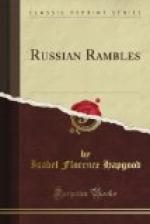“But there is still another plan. [A groan.] The favorite way to give an address is, ‘In the parish of Saint So-and-So.’ It does n’t pin you down to any special house, street, or number, which is, of course, a decided advantage when you are hunting for a needle in a haystack. And the Moscow saints and parishes have such names!” Here the narrator’s feelings overcame him, and when I asked for some of the parochial titles he was too limp to reply. I had already noticed the peculiar designations of many churches, and had begun to suspect myself of stupidity or my cabman and other informants of malicious jesting. Now, however, I investigated the subject, and made a collection of specimens. These extraordinary names are all derived—with one or two exceptions for which I can find no explanation—from the peculiarities of the soil in the parish, the former use to which the site of the church was put, or the avocations of the inhabitants of its neighborhood in the olden times, when most of the space outside of the Kremlin and China Town was devoted to the purveyors and servants of the Tzars of Muscovy.
St. Nicholas, a very popular saint, heads the list, as usual. “St. Nicholas on Chips” occupies the spot where a woodyard stood. “St. Nicholas on the Well,” “St. Nicholas Fine Chime,” are easily understood. “St. Nicholas White-Collar” is in the ancient district of the court laundresses. “St. Nicholas in the Bell-Ringers” is comprehensible; but “St. Nicholas the Blockhead” is so called because in this quarter dwelt the imperial hatmakers, who prepared “blockheads” for shaping their wares. “St. Nicholas Louse’s Misery” is, probably, a corruption of two somewhat similar words meaning Muddy Hill. “St. Nicholas on Chickens’ Legs” belonged to the poulterers,




